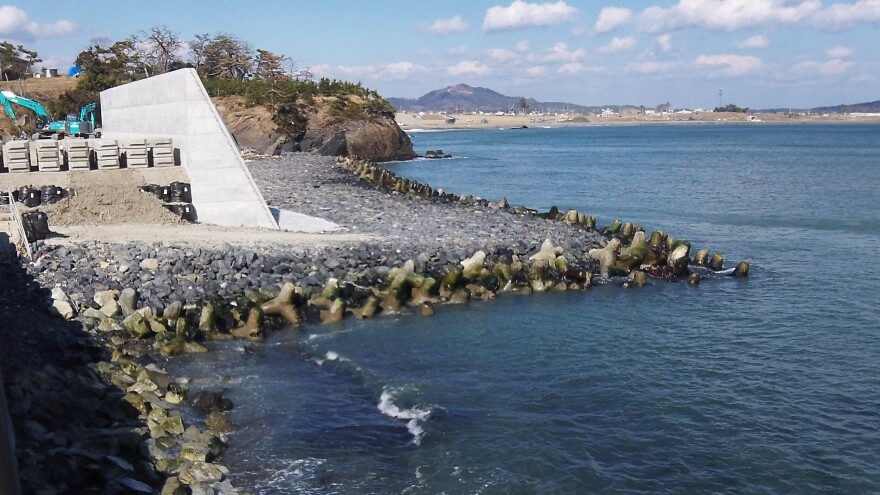Three years after the massive tsunami that ravaged northeastern Japan, the government is building the biggest anti-tsunami barriers ever.
The vast network of supersized sea walls, mocked by some as "the Great Wall of Japan," is already underway and would stretch 230 miles and cost nearly $8 billion.
The wall is designed to protect places like the small port city of Kesennuma in Miyagi prefecture. With its dramatic hills, white fishing boats and seafood market, Kesennuma has the pleasant nautical feel of Seattle.
In a prefab metal building, chefs at the Asahi Sushi restaurant assemble a big takeout order. The original restaurant washed away in the March 11, 2011, tsunami, along with the rest of Kesennuma's historic waterfront.
The city's rebuilding has been slowed down by controversy over the sea wall, to be built along the inner harbor. Residents and business owners say the originally planned nearly 17-foot-high sea wall would turn this quaint seaport into a prison.
"We love this scenery and we're worried about the environmental impact of sea wall construction, which would affect my livelihood," said tsunami survivor and fisherman Makoto Hatakeyama.
But for planners like Mitsutaka Kodama, of Miyagi's harbor restoration department, fortifying the coast is beyond question. More than 1,000 people died in Kesennuma alone, and Miyagi sustained almost 60 percent of the 18,000 casualties of 2011.
"Residential areas and evacuation routes must be protected by high walls," said Kodama. "We can set back the wall, away from the water to create more shoreline, or make it easy to climb to see the scenery, or cover it with greenery."

Despite the horror his community endured, sushi chef Rikio Murakami thinks a sea wall is a bad idea.
"We've never had a sea wall before. We've always coexisted with the sea and we don't like being cut off from it," said Murakami.
'The Pride Of Our Community'
Oya Beach used to be one of the most popular and treasured landmarks in Miyagi prefecture. It's very well-known for its transparent waters and is a popular place for Miyagi residents to spend the summer.
Now the government of Miyagi prefecture wants to build a sea wall more than 30 feet high. It would obliterate the beach, and that upsets some residents.
"Lots of us went to the shore, locals and out-of-towners alike. It was the pride of our community," said Tomoyuki Miura, a local resident. "Kids played there. Older folks strolled on the beach. We even had our own train station right next to it."
Opponents say the walls — although financed by the national government — would saddle struggling local governments with crushing maintenance costs. They say less drastic alternatives, such as moving communities to high ground or developing better evacuation techniques, have not been given enough attention.
Controversy over the wall has reverberated far beyond the disaster zone, in public forums like a recent one at Tokyo's Waseda University.
Nearly half of Japan's coastline has been armored against erosion and storms. Much of it, opponents say, is useless pork-barrel spending, like a proposal to build $20 million sea walls on four uninhabited islands with no commercial value.
Satoquo Seino of Kyushu University says the sea-wall issue in northeastern Japan is already changing national policy.
"This is the first time Japan has seen a concerted movement against building sea walls. Until now it was just a local problem," Seino said.
Despite their opposition, Kesennuma residents have been forced to accept a final compromise with the Miyagi regional government: Within the next two years, the town will have a new 14-foot-high sea wall.
Copyright 2021 NPR. To see more, visit https://www.npr.org. 9(MDIxMDkyNjUxMDE0NDY1Njg1NzRiOTRiYQ000))





